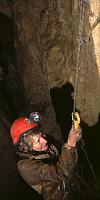
Rope to tight
(click to enlarge)
So your cave goes, and you have reached a large black space. Whether your reaction is joy or terror, there are a few things to consider before leaping, lemming-like, into the void on a handy piece of string, or running back to top camp to announce that the cave is "bottomless".
How deep is the pitch ? Where would be the ideal line of descent, avoiding rub points, loose rock, mud and/or water ? Is there an obvious traverse level across the top of the pitch, or a short way down ? Can you actually see any of this without starting to rig ? Look across the pitch as well as down it - there may be accessible passage still to explore and always a chance that the pitch can be climbed or bypassed entirely. Look up too: if there is an aven it may give a clue as to where flood inlets might appear, or there may be loose rock or ice formations up there to be considered.
The traditional method of judging the depth of a pitch is to lob a rock down. Casteret always used to wrap his rock in a copy of "Le Monde" and set it alight before casting it into the void. Before chucking anything down a pitch, consider whether there could be another party down there, perhaps having come by an entirely different route. In Kaninchenhöhle in particular, this is a very real possibility.
A traverse/security line is often useful to approach the edge of a new pitch. This may or may not become a permanent part of the rigging, but until the safety of the pitch head has been assessed, it is better to be safe than sorry. Such a rope will often enable you to reach a better viewpoint (or rock-chucking point :-) to assess the pitch, and certainly confers a greater degree of confidence when scrambling about looking for potential rig points.
When throwing your rock, only the time to the first bounce is really relevant, unless it continues to rattle on for very much longer. If you can drop it in a "free hang" then this will give you a good idea of the minimum length of rope needed before a rebelay is required.
There are two two obvious tactical errors you can make when rigging a new pitch. On the one hand, you can spend ages bolting a perfect hang, only for the first person to find the pitch ends blind. On the other hand, you can bodge up a rig to check that it goes, then fail to rig properly before it takes a lot of traffic. The first error is frustrating and limits your finding of new stuff. The second error can be terminal at worst and at best can waste a lot more time than would have been needed to rig properly.
If a pitch is roomy, draughts strongly or is in an immensely promising location, it is probably worth taking the time to rig it properly from the start. If the pitch is small, has no draught or is likely to drop back into a known part of the cave, it is probably better to send someone down before investing too much effort. You can make it safe pretty quickly with rope protectors and perhaps deviations off naturals, without taking the time to place bolts which you will need for a more permanent rig.
Experience in the UK should have given you a good feel for when a pitch is well-rigged. It won't take too long in Austria to get a feel for how it can go wrong. If you find a pitch badly rigged by someone else, don't assume it must be OK because they survived. If you can improve the rig, do so; if not, consider carefully whether you should go down at all.
A well-rigged pitch should not be overly gymnastic, nor, ideally, should it have either very long or very short sections, which result in a lot of waiting around for the other person(s) in a group. Loops at rebelays should not disappear when the rope is unloaded, and should be long enough to allow the removal of any type of descender. They do not need to be long enough to stand in - especially if the pitch above is short. Overmuch slack at a rebelay will result in a high fall-factor if the belay fails.